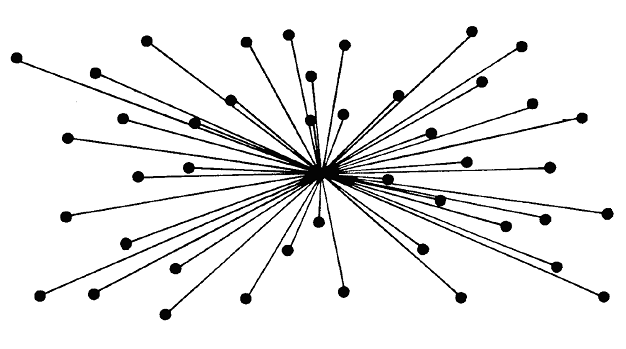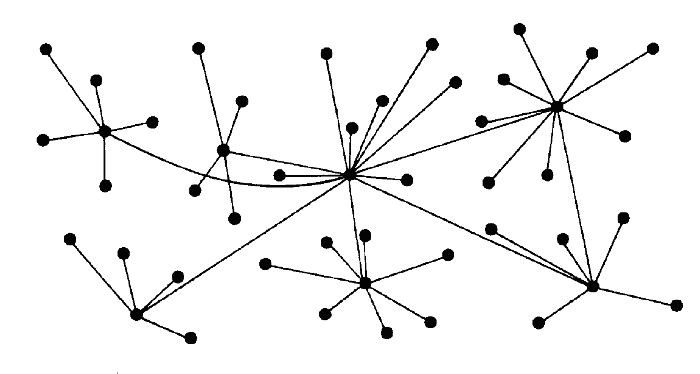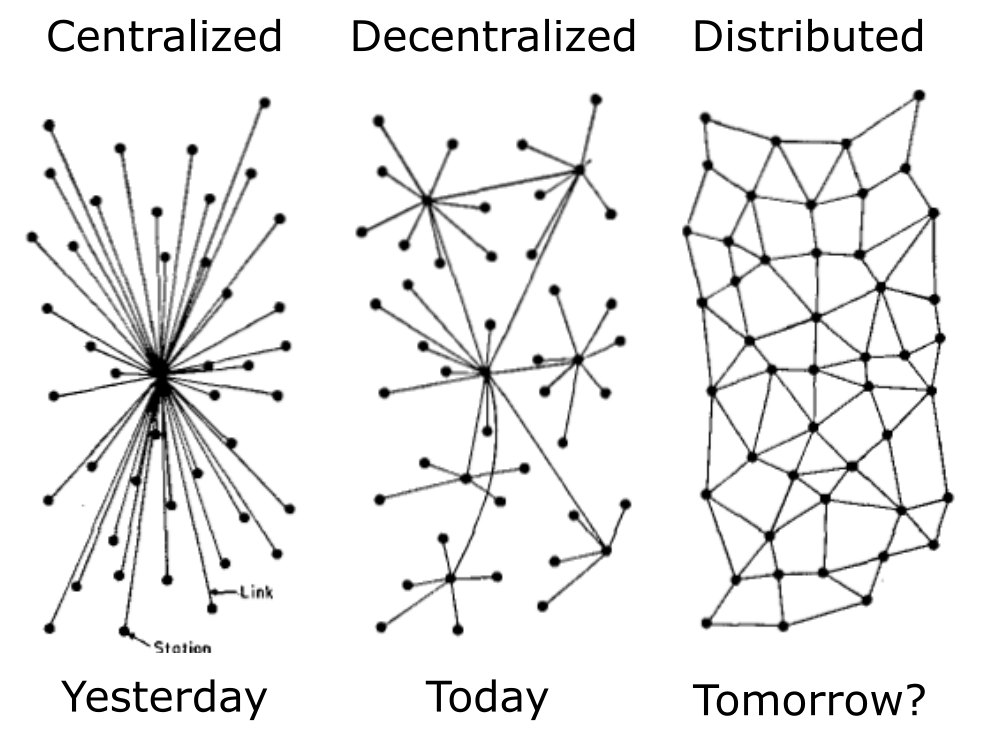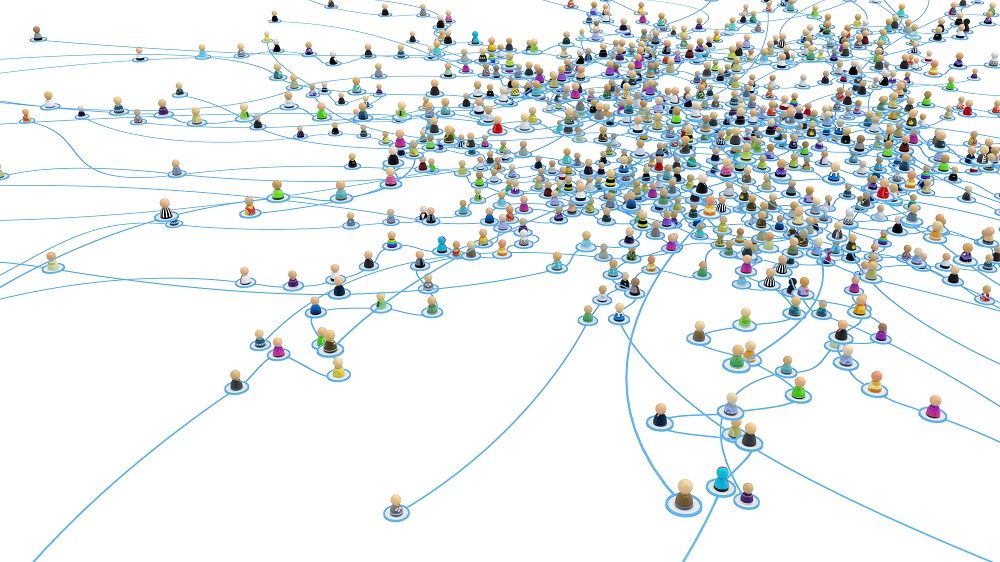Distributed Networks and the Future of Missions Finance
Back in 1962, Paul Baran published an idea about making a more resilient, “survivable” communication system, in light of the Cold War threat. He wanted to figure out a way to keep communications going, even if the main communication centers that everyone depended on got taken out by an enemy attack.1
The “centralized” networks of his day looked something like this:

There were also “decentralized” networks that relied on more than just one single point.

Although these networks were a little more resilient, they were still pretty vulnerable, because it wouldn’t take much to make 2-3 of these main stations collapse, destroying the whole network.
So he suggested moving towards this whole idea of “Distributed Networks.” Rather than everyone depending on a few big central connections, he proposed a system where several hundred little stations would be tied together with many different links.

Communication would be ‘distributed’ throughout the whole network, and not just tied to a few central points. This way, if a number of the stations were attacked or a bunch of connections were to fail, communication could continue as normal. The network would be very resilient.
This was considered impossible and insane at the time, and the big experts at AT&T laughed his ideas off. In fact, they even said he just didn’t understand how voice communication worked.
But it did work. And this new type of network ended up being very reliable, durable, and flexible. He stuck to his convictions and later worked to create something called Arpanet, which became the pre-cursor to the fairly successful project known as the Internet.
Ok, so Paul Baran’s insane ideas ended up totally changing the world. But what does this all have to do with missions and money? I would like to argue that in missions we face a very similar set of problems, and things are changing in the same way that network communications have. Perhaps we can learn something from this move from Centralized to Distributed networks.
Centralized, Distributed, and Decentralized: Three Eras of Mission
Paul Baran talked about three types of networks: centralized, distributed, and decentralized. And I think we can sort of compare these to 3 major ways of sending and funding missionaries. This is by no means a perfect analogy, but I think it can help to get us thinking.

1. Centralized Funding: The Colonial Era

In the earlier days, missionaries were often funded by colonial powers: by state churches of colonial governments, or by large, semi-militant trading companies. For example, some were paid by the Danish Crown to establish and run churches in their colonies, and others were hired by the British East India Company to provide spiritual care for the British people working in foreign lands.
Many saw this as a great open door, and a much needed provision to be able to charge into these lands where western powers were breaking new ground. Also, the salaries provided by these colonial powers provided an attractive sense of financial security.
Henry Martyn, the great pioneer missionary to India and Persia, was lulled into employment by the British East India Company because he was worried about financially providing for his sisters. Those speaking into his life encouraged him to take this job and be sent as a chaplain, seeing it as a wise and responsible thing to do.2
But this great promise of worry-free provision for the young missionary soon turned into a nightmare of distraction and control.
Jesse Page’s biography explains the dilemmas that Martyn constantly faced.
“He had been commissioned by his employers, the East India Company, to go out, not to preach to the natives, but to the English people resident there. Besides this, he held an office which placed him under the control of the military authorities, and he must work within certain limits, and obey his orders as chaplain with the same fidelity and docility as any private soldier in the ranks. A strictly tied up condition of service which could scarcely be otherwise than as fetters and bandages to a spirit yearning to have free course in proclaiming the Gospel.” (p. 65)
Because of his position as an employee of a secular power, he was automatically tied up with their agenda. And they did not want him preaching the gospel to the locals, which was the very thing he was called and burning to do. This put him in tension with the colonial forces, and also brought suspicion and fear to the locals he was trying to reach.
“Strange to say, the rooted idea, born of a guilty instinct, was that if Henry Martyn preached to the natives, it would interfere with the safe government of the country. This feeling was increased by the unexpected arrival of twelve thousand Mahratta troops on this station, and any attempt on the part of the new chaplain to preach the Gospel to them was looked upon with alarm. Such were the foolish hindrances to which he was constantly subject, the English looking askance at him, the natives eyeing him with suspicion as he passed by in his palanquin, so little did they know that the thin, wan-faced missionary was burning with a Christ-like love for their souls.” (p. 94)
He even faced the horror of listening to his employers revel in their battles with locals and seeing them delight in killing and abusing the people that he was aching to reach with the love of Christ.3
I don’t need to go into all the gory details and the well-known brutalities of these colonial powers. Suffice it to say that it was a terrible shame to have people carrying the good news of Jesus paid to carry the flag of the foreign tyrants as well.
I don’t believe everyone jumped into this arrangement because they longed to link arms with these colonial forces. Sadly, some did. But probably most just slid into this kind of employment because it was a “practical necessity” and “what everyone else did.” Looking back, we know that it was a painful and tragic to have God’s servants tied up and dependent on these colonial powers for their missions finance. Even today we are still reaping the spiritual consequences of this terrible mistake.
How did this end?

People naturally rebelled against the colonial powers. All kinds of blood was spilt, and these missionary sending channels were dissolved.
2. Decentralized Funding: The North American Evangelical Era

These days most Western missions sending is done by denominations and other para-church organizations. These groups are organized as registered charities that can present themselves to governments as public societies working for the greater good, and cut tax receipts for donors.
In most of the west, this is the assumed way of operating. Almost everyone is “sent by” some official charity, and people automatically expect to have some official channel they can “give through” and get a tax receipt. Donors have come to expect this, and registered churches are been bound by law to give along these lines. (In Canada, registered churches cannot legally give any money to a missionary. They can only give to the registered charity they might work for.)4
There are many financial upsides to this current arrangement. Charitable groups benefit from a sort of public subsidy, as people are able to get back about 40% of their donations back at tax time. The sending groups and workers also benefit from a host of tax breaks, and they’re even able to pay into pension funds. But there are also downsides that come with this kind of public subsidy.
The problem of legal limitations in the ‘Decentralized’ charity system
With charities, there are some strict guidelines about how people and money can be moved around. In order to follow the law, these sending organizations have to become employers and missionaries their employees. They are not allowed to be a ‘channel’ for funds or to simply pass along ‘gifts’ or ‘support.’5 Funds given are used to hire people and pay salaries, and the charities dispensing the money have to demonstrate that they are controlling and directing the missionaries’ activities.6 Both the employer and the employee are put under a whole host of legal limitations and liabilities, and they are answerable to the government for all their spending and activities.
This creates a problem because money cannot be freely shared without performance requirements and legal strings attached. By the letter of the law, any money given must be used to hire people to complete projects or tasks that the charity controls. It must control and direct the use of all it’s resources.7 In other words: Money cannot be given. It can only be used to hire people to do projects. Read that one more time.
This is a big problem, and it can really restrict the natural flow of grace and provision that should be happening within the body of Christ.
Example A: Jim Joe in Far-i-stan had an unforeseen family medical emergency, and he needs to pay some bills for recovery that his insurance won’t cover. The people of First Grace Church of somewhere-in-Canada feel led to pass around the plate, and send a gift in a time of need. But because of the limitations of charity law, they are not allowed to do this.8
Example B: Bill’s a Canadian missionary, and his closest friend and co-laborer Frank from Holland got evicted from his apartment. Now he’s short on the deposit needed to move his family into another place, and doesn’t know what to do. Bill has more than enough support given to his charity, but unfortunately, he is not able to share any of his extra funds with his friend in need, because that would be illegal.9
See also: A more in-depth discussion of the problems that charitable status creates for the church.
These big charities can feel buried under heavy layers of governance. And these legal requirements can even affect the general character and direction of missionary sending efforts. Workers may feel that they are locked in to the places or the people the their organization is able to ‘assign’ them to. Or they may be loaded down with less-than-ideal projects or plans that they’re employer needs them to follow.
After all, the home sending organization/charity can be called to show the government that they are directing, supervising, and controlling things to produce something objectively measurable.10 And so, missionaries might feel a pressure to perform and produce numbers in a line of work where we need to be operating on faith for humanly impossible things.
Many (myself included) have had excellent, gospel-focused, loving leaders and do not feel the pressure of all the legal weightiness above them. Many are also blissfully unaware of the legal requirements that may be neglected or blurred to let them operate more freely. But for some, the pressures of a business-focused, reporting-driven, legally-handcuffed sending mechanism can crush the missionary spirit.
The problem of public resent: How long will Christian charities survive?
This “decentralized” system of registered charities might be just as vulnerable as the “centralized” system of colonial powers that we mentioned earlier. Many voices have been raised calling for the revoking of tax-exempt status for religious charities, and in the general climate of secularism these charities may not enjoy their public benefits for very much longer.
People have all of their support (and even pensions sometimes) tied up in these groups, which may or may not be around in the years to come. If charities are to be closed down in the near future, it would be quite painful and shocking for many. In Canada, when a group loses charitable status, all the funds are lost, and any properties in their possession are basically repossessed.
How Will This End?
We don’t know how and when the downfall of the great charities could happen, but the trailer could look something like this:
These people and many others are intentionally lobbying to take these religious charities out. It’s important to remember that they are not attacking or persecuting us for our faith. They actually want us to have total freedom to follow and spread our beliefs. They’re just are sick and tired of us taking tax-credits for it. (See this report.) It appears we’ve needlessly offended and angered our neighbors with our use of public funds.
We can’t assume that post-modern Western society will continue tolerating us, let alone allowing us be subsidized by their public money.11 And if massive changes hit and these charities collapse, we will need something far more flexible and resilient.
3. Distributed Funding: Missions in the New Generation?
As these centralized and decentralized systems crumble, we’re left with just a bunch of people, still passionate about Christ’s call to reach the lost, and still bound together by a common task. As it is in many parts of the world, people simply have to give and share with each other as needs arise and as they’re moved by the Spirit.

This is all very simple, and it begs the question… why haven’t we just been doing this all along?? Things probably looked more like this in the early church before we got all this political status, “Christian” empires, and publicly-recognized charities. It was just believers sharing with believers. They do this as they’re moved by the Spirit, to provide for the needs of the body, so that the work can be done.
“There were no needy ones among them, because those who owned lands or houses would sell their property, bring the proceeds from the sales, and lay them at the apostles’ feet for distribution to anyone as he had need.” (Acts 4:34)
With this setup, we have money, shared among believers without any limitations, conditions, or legal stipulations.12 It actually sounds a lot like grace. As a friend observed, these kinds of gifts are just “kingdom dollars,” and may be used as the Spirit leads, without any contracts or legal complications.
“Freely you have received. Freely give.” (Matt 10:8)
In a distributed setup, missionaries can pool their support to take care of some emergency medical expense on the field. Or someone with extra money can share with a fellow worker in need. They are also free to go and work with whoever, wherever the Spirit leads. There are no limitations or legal bindings, and no need to finagle finances or blur the lines in charity law. There’s just accountability, transparency, and honesty between each other and God above, and that is certainly enough.
“From him the whole body, joined and held together by every supporting ligament, grows and builds itself up in love, as each part does it’s work.” (Ephesians 4:16)
Sounds great, but can this actually work?
Paul Baran, the network technology pioneer, suggested building a “distributed” network made up of lots of smaller, weaker, and interconnected pieces. People scoffed at his backward logic. “How could this network of small, cheap pieces possibly be as strong and effective as a big centralized connection to one massive, expensive communication center?”
But when they started building these networks, an amazing thing happened. As they took smaller, weaker components and linked them all together, the network actually got stronger and more resilient.13
And now we face an analogous challenge of faith. Can we possibly survive, move money, and get the work done without these registered charities that we so dearly depend on? Can we keep sending people and without big foundations and multi-million dollar pool-funds? Can we depend upon a network of God’s humble people, giving and sharing as they feel led?
Why not?
“Look at the birds of the air; they do not sow or reap or store away in barns, and yet your heavenly Father feeds them. Are you not much more valuable than they?” (Matthew 6:26)
Nowadays with the internet and e-bank transfers and Paypal, it’s easier than ever to live out this interconnected way of giving and sharing. And the Holy Spirit can move hearts to give and share, organizing the connections and gifts as needed. I’m a missionary who’s been living on this kind of freely “distributed” finance for the last 4 years, and let me tell you, it works great.
Some may deem it craziness to start thinking and working towards operating this now. But let’s remember that in 1960, Paul Baran’s suggestion of something like the Internet seemed like unnecessary madness as well. Back then he asked:
“Is it time now to start thinking about a new and possibly non-existent public utility, a common user digital data communication plant designed specifically for the transmission of digital data among a large set of subscribers?”14
Time has proven that his idea wasn’t as impossible or audacious as it once seemed.
So, let’s ask a similar question: Is it time now to start thinking about a new way of giving and sending missionaries? A way in which we can freely share and see God provide for his people as he sends them out? A way in which we’re not shackled to the employer/employee relationship and the limits of charity law?
Perhaps we’ve inadvertently put our faith in colonial kings, pension-paying companies, or tax-receipted donations as necessities for our provision. We’ve done this for years and years because it’s what’s always been done. Everyone’s told us we needed to. We’ve clung to these setups, fearing poverty and collapse if we were to lose them.
But all along, we’ve had a good father who’s more than eager to provide for his servants as they wholeheartedly and unsurprisingly follow him. He’s been designing and knitting together a beautifully connected and indestructible web of believers that will give, support, and urge each other on in love. We just need to fall back and trust him.
Benefits of “Distributed” Missions Finance
- Reproducible and viral all over the world
- Doesn’t require a lot of money, just ordinary people sharing daily bread
- No government attachment/responsibilities
- No legal issues (audits, liabilities, etc.)
- Doesn’t offend non-believing tax-payers
- Resilient: can survive if big chunks are disrupted or attacked
- Scalable: it can work with tiny networks or huge sending groups
- Freely shareable, allows flexibility and movement
- Allows giving to happen without ‘employment’
- Makes us small and inter-dependent, putting us on the grid of faith
Please remember that this is all a very imperfect analogy and I am trying to make a point particularly as it relates to money in particular. I am not suggesting that we should abolish any kinds of leadership and forget the precious groups of people working in sending groups etc. We do desperately need Godly examples, shepherds, administrators and overseers. And I do believe some form of centralized administration can be a huge help in sending. So we probably shouldn’t take this picture of an entirely ‘distributed’ network too far.
But I do believe that we will need to move toward a more distributed way of sharing funds and sending people, so that God’s resources can move freely through the body, as he alone directs them. I hope some of these strange thoughts can nudge us to start re-thinking how we handle missions finances as a body, so that groups and individuals can move away from the vulnerable funding systems that are centralized under some form of government assistance and control.
For a more information about the damaging effects of charitable status for the church in general, visit https://nomorecharitablestatus.com/.
What do you think? Comments or corrections are welcome below. note: anonymous comments are allowed. Just click on the ‘sign up with Disqus’ option below and choose to post as a guest or under a different name.
other articles...
Footnotes:
-
See Paul Baran Wikipedia entry. ↩
-
Jesse Page, (2003) Henry Martyn: Pioneer Missionary to India and Islam. Ambassador Publications (p. 40, 41) ↩
-
Ibid., (p. 58) ↩
-
Guidance CG-002, Canadian Registered Charities Carrying Out Activities Outside Canada, Canada Revenue Agency ↩
-
“Neither the common law nor the ITA (with the limited exception of the qualified donee rule) permit a charity to act as a conduit for passing on resources. This means a charity cannot take in resources and channel them to an individual, an organization or a corporation, etc.” p. 133 2010 Charities Handbook, CCCC ↩
-
In Canada, a registered charity must, “control and direct the use of all its resources (funds, personnel, and property)” Guidance CG-002, Canadian Registered Charities Carrying Out Activities Outside Canada, Canada Revenue Agency See also chapter 3, section 6 (“Direction and Control”) of the CCCC Charities Handbook. ↩
-
Any registered charity in Canada can only use money in two ways: 1. Carrying out its own charitable activities through its staff or a (directed and controlled) intermediary. 2. Making gifts to ‘qualified donees.’ (ie. another registered charity) “A charity must direct and control the use of its resources.” Guidance CG-002, Canadian Registered Charities Carrying Out Activities Outside Canada, Canada Revenue Agency. For further explanation see the Charities Handbook, CCCC (ch 3, Carrying Out Charitable Activities). ↩
-
The Charities Handbookof the CCCC explains clearly how this is illegal. In fact even free love offerings are illegal in registered churches. A plate could only possibly be passed around if it was used to pay a speaker for a specific sermon, and there was a pre-decided cap on how much was decided, for instance. (see ch. 3) ↩
-
This would be illegal and impossible on a number of levels. First of all, Bill does not technically have any “support” or money given to him on the field. Donors give to his employer the charity, so that they can hire people to do their work. They do not give to Bill, or to Bill’s support. From this pile of money, Bill can only receive his wage, or money for ministry projects that the charity directs. “The first principle is that in spite of God’s involvement in calling the workers and His desire to see the work succeed, in the eyes of the law, a mission is like any other employer. … Like any employer, the mission cannot support a missionary ‘doing his own thing’, but rather must give direction to the missionary. … It is important to remember that the mission and missionary are, in the eyes of the law, in an employer-employee relationship.” David Johnson “Administering Missionary Expenses” Canadian Council of Christian Charities, May 2008, Issue 3. Also see “Charities Handbook” CCCC (ch. 16 The Employment Relationship) ↩
-
Guidelines for Registering a Charity: Meeting the Public Benefit Test, CPS-024, Canada Revenue ↩
-
A number of legal sources and academics have explained how tax-credits and tax-exemptions do actually work as a form of public subsidy. See Webb, K. R. (2000). Cinderella’s slippers?: The role of charitable tax status in financing Canadian interest groups. Vancouver: SFU-UBC Centre for the Study of Government and Business. Or as Educaloi explains, “Governments therefore give up large amounts each year that they would have collected in taxes if charities were not issuing receipts.” Secular people have understood this, and it seems to be the chief reason for their frustration with religious charities. See Matthew Yglesias, We Should Be Taxing Churches, Slate. Dylan Matthews, “You give religions more than $82.5 billion a year”, Washington Post. “Charitable Status for Advancing Religion: Submission to the Standing Committee on Finance House of Commons, Parliament of Canada” Canadian Secular Alliance (2014) ↩
-
When someone gives a friend or a relative $500, there is no need to consider it wages or income. The person is not giving it to pay for a religious service, or to get a certain religious project done. They’re just sharing it with a friend, no strings attached. And so there should be no legal or tax issues. ↩
-
The networks stayed resilient even when up to 50% of the nodes were destroyed. see Paul Baran - Packet switched network design on Wikipedia ↩
-
Paul Baran, (1962) (On Distributed Communications Networks, RAND Corporation, p. 40 ↩

